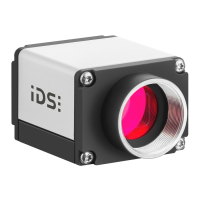© 2009 IDS Imaging Development Systems GmbH 27
6 Camera Basics
immediately effective for next image, however.
· Freerun mode
In freerun mode, the camera is internally busy with capturing the next image while new parameters
are transmitted to the camera. Depending on the exact time of transmission, new parameters
might only come into effect two or even three images later.
· Trigger mode
In this mode, the camera reverts to idle state between two images. When you change the camera
parameters, the new settings will be applied immediately to the next image (delayed by one
additional image for the UI-122x-C/M or UI-522x-C/M cameras due to the sensor).
6.1.5 Image Display Modes
The uEye driver provides three different modes for the display of captured images: The device
independent Bitmap mode (DIB), DirectDraw BackBuffer mode and DirectDraw Overlay mode.
· Device Independent Bitmap mode (DIB)
In Bitmap mode, images captured by the uEye are written to the random access memory of the
PC. The application software initiates the image display by the graphics card. This may result in a
slightly higher CPU load as compared to the DirectDraw display.
The advantage of Bitmap mode is that it is compatible with all graphics cards and that image data
in the memory is directly accessible. Since Windows controls the image display, the image may
be completely or partly overlapped by any other windows and dialog boxes.
· DirectDraw BackBuffer mode
In this mode, the uEye driver writes the image data to the invisible memory area (back buffer) of
the graphics card. This process runs automatically and does not have to be controlled by the
application software. It requires an installed DirectDraw driver, sufficient memory on the graphics
card and back buffer function support by the graphics card.
For this purpose, graphics cards generally provide better performance than graphics chips
integrated on the mainboard. In DirectDraw mode, the CPU load may be lower than in Bitmap
mode.
· DirectDraw Overlay Surface mode
This mode enables simultaneous display of a live image and overlay data. The video image is
digitized and stored in an invisible memory area (back buffer) of the graphics card. Defining a key
color and drawing that color to the image output window results in the video image being displayed
in all areas of the output window that have this key color. If the key color fills the entire window,
the video image is displayed full-screen. Accordingly, graphics/text data is preserved in all areas
not filled with the key color. This produces a non-destructive overlay. The display is controlled by
the graphics card chip and therefore hardly requires any CPU time. This mode is not supported by
all graphics cards, and often, it can only be used in conjunction with the YUV color mode.

